IELTS Listening
Map Vocabulary
5 sets of IELTS Listening map vocabulary with maps, plans and sample sentences to help you learn.
To do well in map and plan questions, you need to understand the language of location, especially prepositions of place, and direction.
Here are definitions of these two types of vocabulary to make sure that you understand the difference between them, and a few examples of each type.
- Location – where something is in relation to another object or place.
- Direction –
the position towards which someone moves or faces.
Common
vocabulary of location:
near, in front of, next to, beside, across from, between
Common vocabulary of direction:
turn right, turn left, go straight on, travel northwest, go past
Below, you’ll
find lists of vocabulary commonly used in map and plan questions, along with
sample sentences to show the words and phrases used in context. Each set of sentences
describes or gives directions on a map or plan to give you some practice at visualising
the information as you'll have to do in your test.
We’ll start with some simple prepositions of place.
IELTS
Listening Map Vocabulary – Set 1
- facing
- in the middle / centre of
- behind
- between
- next to / by
- in front of
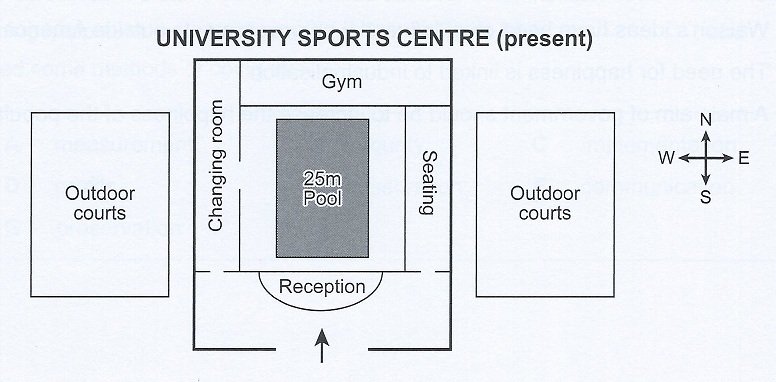
Source: Cambridge English past paper
The entrance is in front of the reception desk.
The reception desk is facing the entrance.
The pool is in the centre of / in the middle of the sport’s centre.
The gym is behind the swimming pool.
The pool is between the reception and the gym.
The seating area is next to / by the pool.
IELTS
Listening Map Vocabulary – Set 2
- left-hand side
- right-hand side
- turn right
- to your right
- pass through
- on the other side
- beyond
- along
- corner
- go straight
- beside
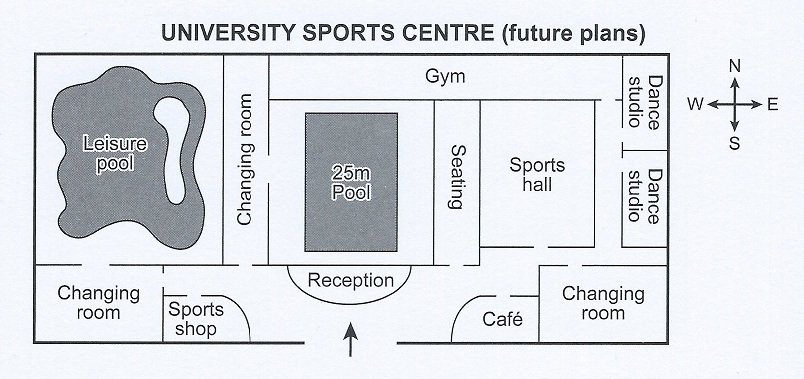
Source: Cambridge English past paper
The sports shop is on the left-hand side as you enter the sports centre.
To the right-hand side of the entrance, there’s a café.
Pass through the entrance, turn right and the café is immediately in front of you.
The leisure pool is on the other side of the sports centre to the dance studios.
There is a large changing room just beyond the café.
Walk along the side of the sports hall and you’ll find the second dance studio in the far corner of the building
Go straight along the corridor beside the sports hall and to your right, you’ll see two dance studios.
IELTS
Listening Map Vocabulary – Set 3
Maps nearly always have compass points shown. You need to know the 8 points of the compass as these are often used in the recording to describe position. The 8 points are:
- north
- south
- east
- west
- northeast
- northwest
- southeast
- southwest
There are several different ways you might hear them used.
- to the north / to the south …
- in the northeast / in the southwest …
- north side / east side / west side / south side
- heading east
- slightly west of
- just southeast of
Other vocabulary:
- near
- first / second
turning
- on the left
- straight ahead
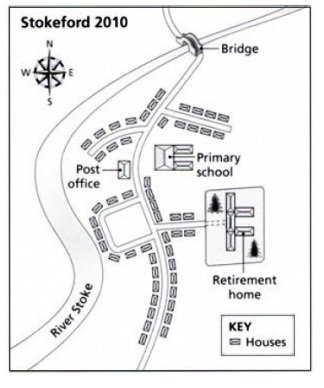
Source: Cambridge English past paper
The houses immediately to the north and south of the Post Office are very near the river.
The bridge is just beyond the final row of houses heading north.
After crossing the bridge, take the second turning on the left and you’ll see the retirement home straight ahead.
The retirement home is just southeast of the primary school.
The post office is to the northwest of the retirement home.
The village of Stokeford is slightly east of the River Stoke.
There is a housing estate to the west side of the retirement home.
IELTS
Listening Map Vocabulary – Set 4
- opposite
- across the
road
- same side
- before you get to
- junction
- dead end
- leads off
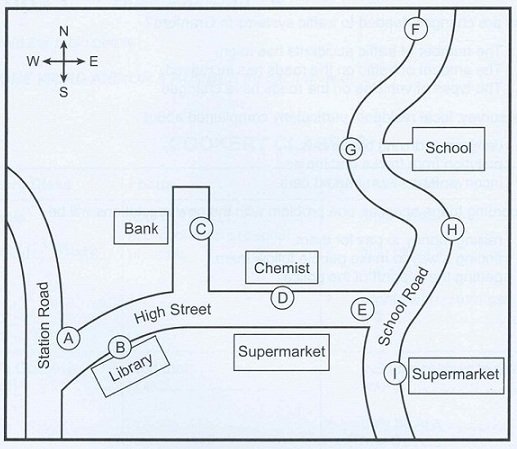
Source: Cambridge English past paper
The chemist is opposite a supermarket.
They are going to build new houses across the road from the school at point G.
There is a supermarket on the same side of the road as the library.
Walk west along High Street and you’ll pass the library before you get to the junction with Station Road.
The bank is on a dead end road that leads off the High Street.
IELTS
Listening Map Vocabulary – Set 5
- bend
- just past
- alongside
- adjoining
- carry straight on
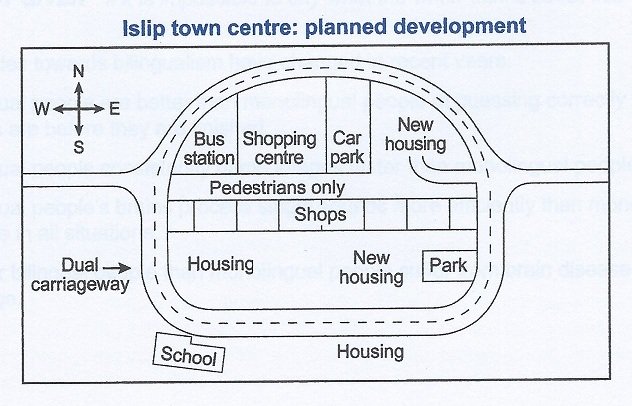
Source: Cambridge English past paper
The school is situated on a bend in the dual carriageway.
The bus station is on the right just past the shopping centre.
The town centre has a pedestrian walkway running alongside a row of adjoining shops.
After passing the school on your right, carry straight on and you’ll see the park on your left around the next bend.
Practice using this vocabulary to describe places you know and it will soon become familiar.
Also study my lesson on How To Answer Map and Plan Questions and practice answering IELTS Listening map and plan questions from past papers.
Want to watch & listen to this lesson?
Click on this video.
Like this page?
IELTS Listening – All Lessons
IELTS Listening Test – Understand the format & question types. Know what skills are assessed. Also, discover 3 important marking tips.
Listening Strategies – Learn 3 essential listening strategies – question analysis, answer prediction & how to use keyword clues.
Listening Skills – Learn the 4 key listening skills needed for a high score highly. Examples from real questions.
Listening Exercises – 8 listening exercises to help you recognise & learn vocabulary for 6 common topics – time, numbers, prices, dates, letter names & addresses.
The 10 Question Types – Examples of all 10 types of Listening questions. Learn how to recognise & understand them. Links to 10 step-by-step lessons.
Listening Tips – Top 10 tips to bring you success in your Listening test. Essential information you need to know to achieve a high score.
How to Improve Your Listening Skills – 6 simple strategies essential for achieving a high score in the test.
Listening Practice – 4 practice techniques to develop your listening skills
Map & Plan Vocabulary – Learn the vocabulary you need for your test. 5 maps & plans with sample sentences containing common vocabulary of location & direction.
Listening Practice Samples – Short activities to improve your listening skills & help you learn topic vocabulary.
Genuine Full Practice Tests:
The 10 Question Types
Click the links below to learn how to answer each type of question.









